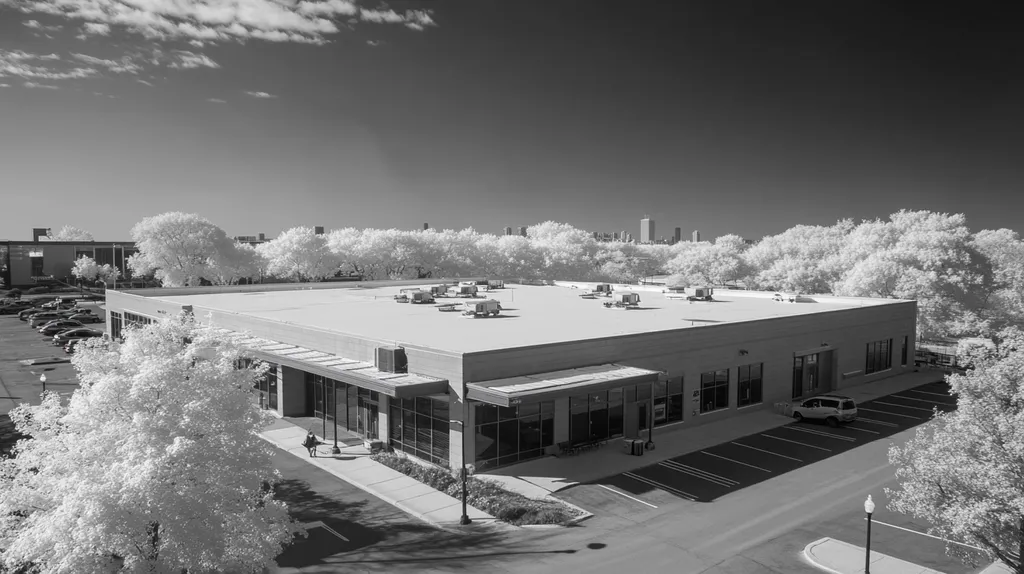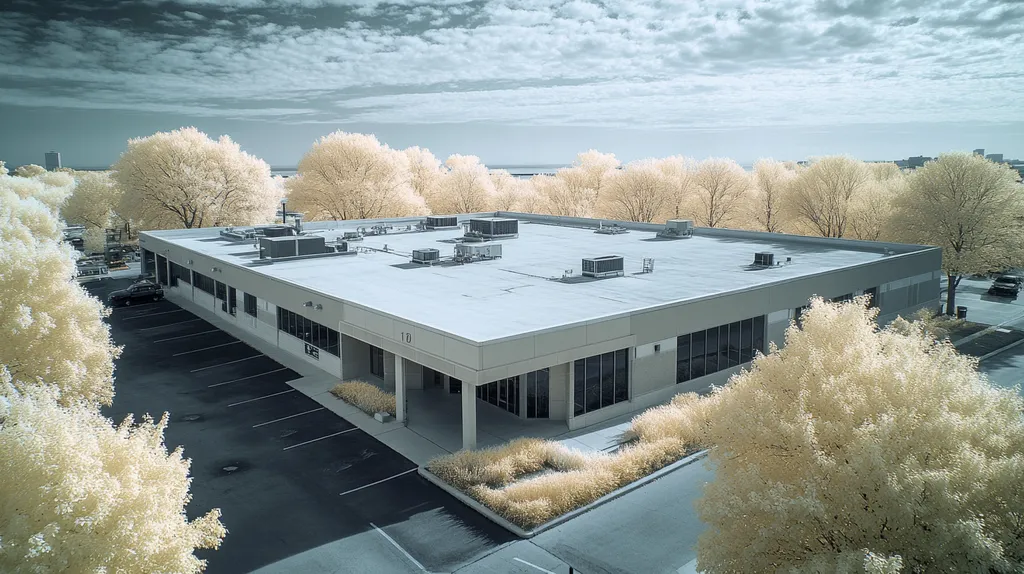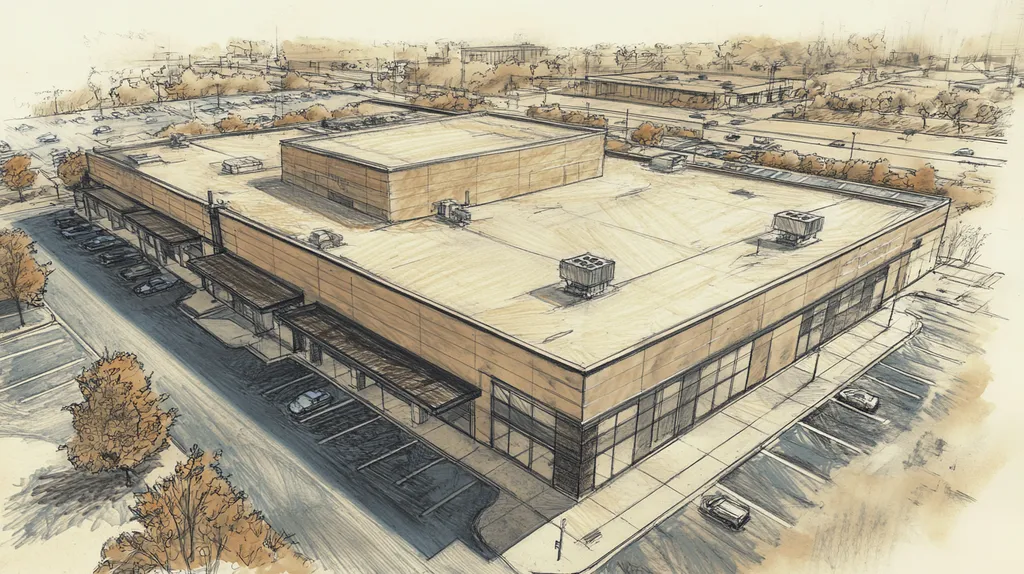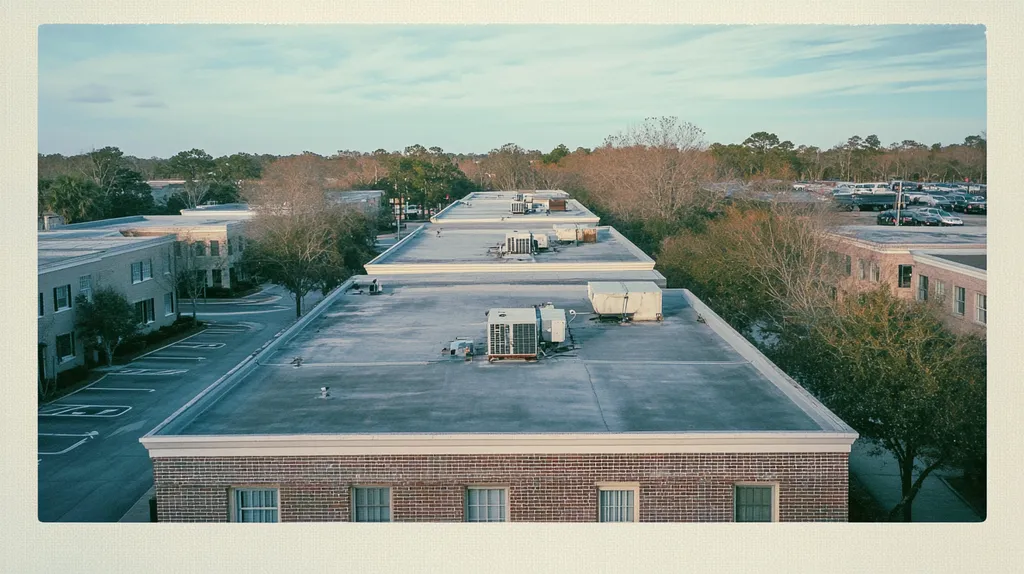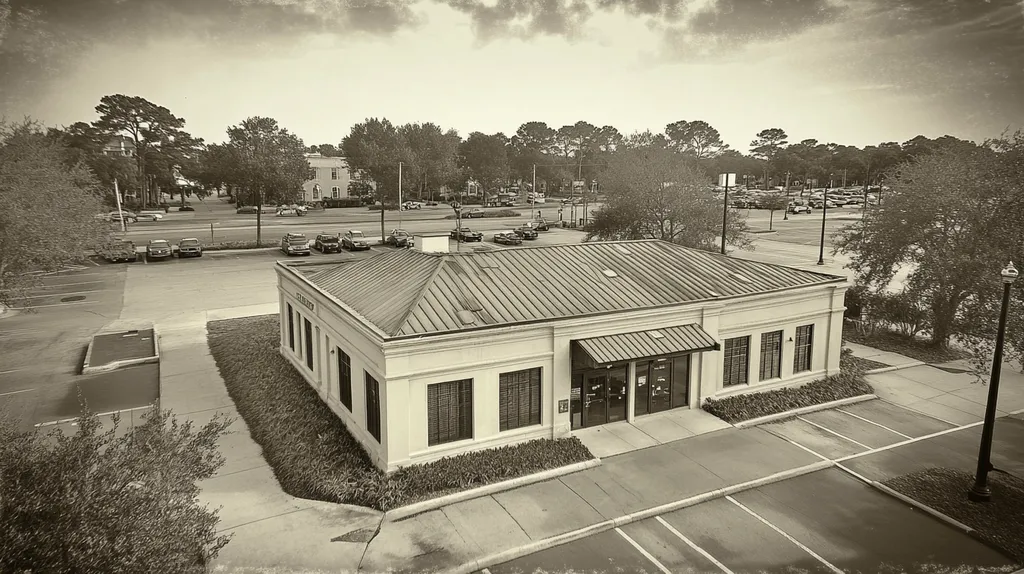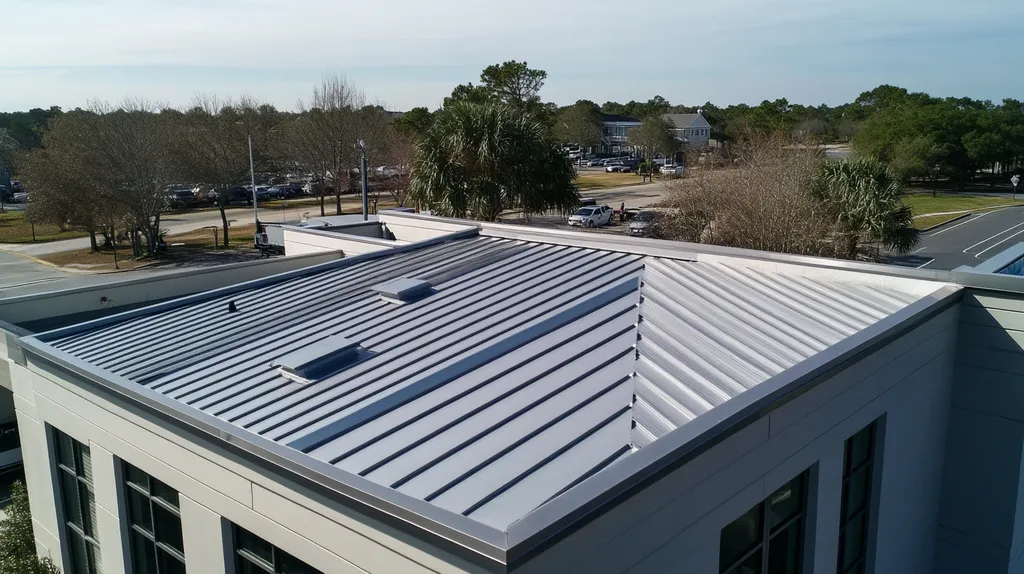When water starts streaming through a commercial roof, facility managers have minutes—not hours—to prevent thousands in damage and operational shutdown.
A single delayed decision can transform a manageable leak into a business catastrophe that spreads throughout electrical systems, inventory, and critical equipment.
Emergency roof leak response isn’t just about stopping water—it’s about preserving business continuity while minimizing repair costs and downtime.
This guide breaks down the essential protocols, terminology, and decision factors that separate successful emergency interventions from costly disasters.
SECTION 1: THE BASICS EXPLAINED
When a commercial roof starts leaking, facility managers face a ticking clock. Within hours, a small breach can escalate into widespread water damage, disrupting operations and triggering thousands in repair costs.
The difference between a manageable incident and a business catastrophe often comes down to how quickly you implement emergency measures. Understanding these critical response protocols protects your building, your budget, and your peace of mind.
What It Is (In Plain Language)
Emergency roof leak measures are rapid-response actions that stop or control water intrusion until permanent repairs can be completed. Think of them as emergency bandages for your building – temporary but absolutely essential.
These measures include applying waterproof patches directly over leak sources, positioning heavy-duty tarps to redirect water flow, and clearing blocked drains that could worsen flooding. The key is speed and effectiveness, not perfection.
Common emergency tools include roofing cement for small holes, self-adhesive membrane patches for tears, and weighted tarps for larger damaged areas. Professional emergency teams also use specialized sealants that work even in wet conditions.
The goal isn’t to permanently fix the roof – it’s to buy time while preventing further damage to your building’s interior, equipment, and operations.
Why It Matters (To Your Building)
A true emergency involves a leak that threatens safety, disrupts business operations, or risks damaging high-value assets. Rapid action can drastically reduce the scope of damage, making immediate repair necessary to prevent further deterioration and business downtime.
Water doesn’t just create puddles – it seeks the path of least resistance through insulation, ceiling tiles, and electrical systems. A single leak can shut down entire sections of your facility within hours.
Beyond immediate operational disruption, untreated moisture creates long-term problems like mold growth, structural weakening, and indoor air quality issues. These secondary effects often cost more than the original roof repair.
Insurance companies also scrutinize how quickly building owners respond to leaks. Delayed action can reduce claim payouts and increase future premiums. (source: Roof Consultants Specialists)
How It Works
Effective emergency response starts with rapid leak location and assessment. Trained responders trace water entry points, which aren’t always directly above where you see dripping inside.
Once identified, they apply immediate containment measures – sealing small holes with roofing cement, covering larger areas with waterproof membranes, or installing temporary drainage systems to redirect water safely away from the building.
Interior protection runs parallel to exterior repairs. This includes setting up water collection systems, moving sensitive equipment, and creating barriers to prevent water spread.
Throughout the process, documentation is critical for insurance claims and permanent repair planning. Photos, measurements, and detailed damage reports ensure nothing gets overlooked.
The emergency phase continues with monitoring and adjustment until weather conditions allow for permanent repairs or until roofing contractors can implement long-term solutions.
SECTION 2: PRACTICAL APPLICATIONS
Emergency roof leak measures transform chaotic water intrusion events into manageable situations with predictable outcomes. A manufacturing facility that experiences a sudden membrane failure during peak production can maintain operations while emergency patches contain the damage.
The key lies in understanding when, where, and how to deploy these critical interventions. Smart facility managers recognize that emergency measures aren’t just about stopping water – they’re about preserving business continuity and protecting valuable assets until permanent solutions arrive.
Common Uses & Examples
Heavy-duty tarps secured with sandbags or water barrels represent the most versatile emergency response for large damaged areas. A distribution center facing a torn membrane can deploy weighted tarps within hours, redirecting water away from stored inventory.
Cold-applied liquid sealants excel at sealing cracks around penetrations and flashing details. These rubberized compounds cure quickly even in wet conditions, making them ideal for active leak situations where traditional patches won’t adhere.
Self-adhesive membrane patches provide permanent-quality repairs for punctures and small tears. Emergency teams often carry pre-cut patches in standard sizes, allowing rapid deployment without measuring or cutting materials on-site.
Roofing cement mixed with reinforcing fabric creates durable repairs for irregular damage patterns. This combination works especially well on modified bitumen and built-up roof systems where matching existing materials matters.
Professional emergency teams deploy specialized equipment like portable hot air welders for thermoplastic membranes. These tools enable field repairs that match the strength and durability of original installation methods.
When You Need It Most
Severe weather events create the highest-stakes scenarios for emergency roof repairs. Hailstorms can puncture hundreds of square feet of membrane in minutes, requiring immediate triage to identify and seal the most critical leak points first.
Equipment failures during off-hours demand rapid response to prevent operational disruptions. When a restaurant’s walk-in cooler sits directly below a weekend roof leak, emergency measures preserve thousands of dollars in perishable inventory.
Construction delays often extend temporary repair periods beyond initial expectations. A hospital that discovers structural issues during planned roof replacement must maintain watertight conditions for months, not days, requiring more robust emergency solutions.
Contractor scheduling conflicts can leave buildings vulnerable between initial damage and permanent repairs. Emergency measures bridge these gaps, preventing minor leaks from becoming major structural problems.
Insurance claim investigations sometimes require temporary stabilization while adjusters document damage. Quick-response teams preserve evidence while preventing additional losses that could complicate claim settlements.
Interactions With Other Systems
HVAC equipment positioned near leak sites requires immediate protection to prevent electrical damage and system shutdowns. Emergency teams often install temporary barriers around rooftop units before addressing the leak source itself.
Building automation systems can complicate emergency repairs when sensors trigger false alarms or automatic shutdowns. Coordinating with facility management ensures that temporary repairs don’t interfere with fire suppression, security, or climate control operations.
Structural considerations become critical when emergency repairs involve heavy materials or equipment. Loading calculations for temporary supports, water-filled barriers, and repair teams must account for existing roof capacity limitations.
Drainage systems often require clearing or temporary rerouting during emergency repairs. Blocked drains can turn minor leaks into major flooding events, making drainage assessment a priority step in any emergency response.
Interior coordination prevents emergency repairs from creating secondary damage below the roof level. Strategic placement of water collection systems and protective barriers ensures that roof repairs don’t disrupt ongoing business operations.
SECTION 3: KEY TERMINOLOGY DECODED
When emergency roof leaks strike, miscommunication with contractors can cost precious hours while water damage spreads throughout your facility. A facility manager who confuses “ponding water” with “active dripping” might prioritize the wrong repair areas, allowing structural damage to accelerate.
The roofing industry operates with specialized terminology that sounds like a foreign language to most property owners. Understanding these critical terms enables faster decision-making and more effective coordination during crisis situations.
Essential Terms Explained
“Membrane” represents your roof’s primary waterproof barrier – typically TPO, EPDM, or modified bitumen materials that keep water out of your building. When contractors mention membrane damage, they’re identifying the exact source of your leak problem.
“Flashing” refers to metal strips installed around roof penetrations like vents, pipes, and HVAC units to seal potential water entry points. Failed flashing causes 80% of commercial roof leaks, making it the first place emergency teams investigate.
“Ponding water” describes areas where water collects and remains on your roof for more than 48 hours after rainfall. These stagnant pools create constant pressure against your roof system and often indicate drainage problems that worsen during storms.
“Substrate” means the structural deck beneath your roof membrane – usually concrete, metal, or wood decking. Water reaching the substrate signals serious emergency conditions requiring immediate professional intervention.
Industry Jargon Translated
“Hot tar” and “cold patch” represent two different emergency sealing approaches contractors use to stop active leaks. Hot tar requires heating equipment and works best for permanent-style repairs, while cold patches apply directly from containers for quick fixes.
“Tapered insulation” creates intentional slopes that guide water toward roof drains, preventing the ponding conditions that cause most emergency situations. When contractors mention insulation problems, they’re often explaining why water isn’t draining properly.
“R-value” measures insulation’s ability to resist heat transfer and becomes relevant when leak repairs require replacing water-damaged insulation layers. Higher R-values mean better energy efficiency but also indicate thicker materials that take longer to dry.
Emergency teams use buckets and temporary barriers to “contain the leak” by catching water and preventing it from spreading to undamaged areas. Simple containment measures like piercing bulging ceilings prevent secondary damage while permanent repairs get organized. (source: Joyland Roofing & Exteriors)
Measurement & Units Simplified
Roofing contractors measure damage in “squares,” with one square equaling 100 square feet of roof area. A “five-square emergency repair” means 500 square feet of your roof needs immediate attention to prevent further water intrusion.
Moisture readings appear as percentages on specialized meters, with readings above 20% indicating serious water saturation requiring urgent action. These measurements help emergency teams prioritize which areas need immediate drying and which can wait for scheduled repairs.
“Mil thickness” describes membrane thickness in thousandths of an inch, typically ranging from 45 to 80 mils for commercial applications. Thicker membranes resist puncture damage better but cost more for emergency patch materials.
“Slope measurements” appear as ratios like 1:48, meaning one inch of rise per 48 inches of horizontal distance. Insufficient slope creates the ponding conditions that turn minor roof defects into major emergency leak situations.
SECTION 4: DECISION FACTORS
When water starts pouring through your commercial roof, every decision carries immediate financial consequences. A warehouse manager choosing between a $500 tarp solution and a $2,000 professional patch faces a critical calculation – not just about upfront costs, but about operational disruption, repair longevity, and potential secondary damage.
Emergency roof repairs force property managers into high-stakes decision-making under intense time pressure. Understanding the key factors that drive successful outcomes helps facility managers navigate these critical choices with confidence, even when water is actively damaging valuable assets below.
Cost Considerations
Emergency repair costs extend far beyond material prices, encompassing labor premiums, operational disruptions, and potential cascading damage. A manufacturing facility that chooses a $300 quick-fix sealant over a $1,200 professional membrane patch may face production shutdowns worth thousands when the temporary repair fails during the next storm.
After-hours and weekend emergency service typically carries 50-100% labor premiums, making material quality decisions even more critical. Contractors charging premium rates for emergency calls often recommend higher-grade solutions that justify the increased labor investment through extended performance.
Insurance deductibles and coverage limitations significantly impact cost calculations during emergency situations. Many commercial policies require property owners to mitigate damage immediately, meaning delayed action to save money can actually void coverage for resulting water damage.
Hidden costs emerge when emergency repairs interfere with building operations or require specialized access equipment. A retail store facing ceiling leaks during peak shopping season must factor lost revenue alongside repair expenses when evaluating solution options.
Long-term cost analysis reveals that emergency repairs costing 20-30% more upfront often save money by eliminating repeat service calls and extended downtime periods.
Performance Trade-offs
Weather resistance capabilities vary dramatically between emergency repair options, with some solutions failing completely when exposed to temperature extremes or high winds. Liquid sealants that work perfectly in moderate conditions can crack and separate during freeze-thaw cycles, turning temporary fixes into recurring problems.
Installation speed often conflicts with performance reliability, forcing facility managers to balance time pressure against repair durability. Self-adhesive patches install quickly but may not bond properly to wet or cold surfaces, while heat-welded repairs take longer but create stronger, more weather-resistant seals.
Building movement from thermal expansion challenges different emergency repair materials in unique ways. Rigid patches may crack as the roof expands and contracts, while flexible membranes accommodate movement but cost more and require specialized installation techniques.
UV exposure degrades many emergency repair materials rapidly, particularly temporary sealants and plastic sheeting designed for short-term use. Materials that perform well initially may deteriorate within weeks when exposed to direct sunlight, requiring replacement sooner than anticipated.
Traffic tolerance becomes critical for roofs requiring regular maintenance access or equipment servicing. Emergency repairs using lightweight materials may provide adequate waterproofing but fail when maintenance crews walk across them, creating new leak points.
Lifespan & Durability Factors
Emergency repair longevity depends heavily on environmental conditions, with coastal facilities facing salt air exposure and industrial buildings dealing with chemical vapors that accelerate material breakdown. A patch expected to last six months in suburban conditions might fail within weeks in harsh industrial environments.
Material compatibility with existing roof systems affects long-term performance significantly, as incompatible materials can cause chemical reactions that weaken both the repair and surrounding roof areas. Modified bitumen patches applied over EPDM membranes may create adhesion problems that worsen over time.
Seasonal timing influences durability expectations, with repairs installed during moderate weather typically outperforming those applied during temperature extremes. Spring installations often achieve better adhesion and longer service life than emergency repairs completed during winter or peak summer conditions.
Traffic patterns and building use intensity determine appropriate durability specifications for emergency repairs. Office buildings with minimal roof access can utilize lighter-duty solutions, while industrial facilities requiring regular equipment maintenance need repairs that withstand repeated foot traffic and tool exposure.
Professional-grade emergency materials typically provide 6-18 month service life, while contractor temporary solutions may only last 30-90 days depending on weather exposure and installation quality.
SECTION 5: COMMON CHALLENGES
Emergency roof repairs fail at alarming rates – industry data shows that 40% of temporary fixes require re-work within 30 days, often during the next weather event. A pharmaceutical warehouse that experienced multiple patch failures during hurricane season faced $180,000 in damaged inventory when their “emergency solution” collapsed under sustained rainfall.
The difference between successful emergency interventions and costly failures lies in understanding common pitfalls before crisis strikes. Smart facility managers recognize that emergency challenges follow predictable patterns, making preparation and proper response techniques essential for protecting both immediate operations and long-term building integrity.
Frequent Problems & Solutions
Surface preparation represents the most common failure point in emergency repairs, with contractors rushing to apply patches over wet, dirty, or cold membrane surfaces. Water trapped beneath emergency patches creates blistering and adhesion failure within weeks, turning temporary solutions into recurring nightmares.
Proper surface preparation requires removing all standing water and debris, even during active leak situations. Professional teams use specialized drying equipment and surface cleaners that work in wet conditions, ensuring patch materials bond correctly despite challenging circumstances.
Material incompatibility causes delayed failures that appear weeks after seemingly successful emergency repairs. Modified bitumen patches applied over TPO membranes can create chemical reactions that weaken both materials, while silicone sealants prevent permanent repairs from adhering properly later.
Emergency teams solve compatibility issues by carrying membrane-specific repair materials and understanding which products work with existing roof systems. Quick field tests help identify membrane types when building records aren’t immediately available.
Inadequate weather protection during installation leads to immediate repair failures, particularly when teams attempt permanent-quality repairs during active storms. Temperature and moisture conditions that prevent proper curing cause even high-quality materials to fail catastrophically. If damage occurs while building occupants are present, immediate evacuation ensures safety before attempting any emergency measures like tarping to prevent water damage and support insurance documentation.
Professional emergency protocols include weather monitoring and staged repair approaches that prioritize containment over perfection during severe conditions. Teams focus on stopping water intrusion first, then upgrade to permanent-quality repairs when conditions improve. (source: GoBlusky)
Warning Signs To Watch For
Interior ceiling stains often appear days or weeks after roof damage occurs, making early exterior inspection critical for preventing emergency situations. Facility managers who wait for interior signs typically face repair costs 3-5 times higher than those who catch problems at the roof level.
Systematic roof walks after weather events reveal loose flashing, membrane lifting, and debris accumulation before they create leak pathways. Training maintenance staff to recognize early damage signs enables intervention before emergency measures become necessary.
Unusual odors and indoor air quality changes frequently signal hidden moisture problems developing within roof assembly layers. These conditions create the perfect environment for mold growth and structural deterioration that complicate emergency repairs significantly.
HVAC system performance changes can indicate roof damage affecting insulation and vapor barriers. Increased energy costs or difficulty maintaining temperature often reflect moisture intrusion that hasn’t yet created visible interior damage.
Drainage system performance provides early warning of developing problems, with slow-draining roof areas indicating potential membrane damage or structural settling. Regular drainage testing during maintenance visits identifies problem areas before they fail during storms.
Equipment vibration and building movement can stress roof systems gradually, creating hairline cracks that become emergency situations during weather events. Monitoring high-vibration areas helps predict where emergency repairs might be needed.
Preventative Approaches
Scheduled inspection programs dramatically reduce emergency repair frequency by identifying and addressing problems during favorable weather conditions. Facilities with quarterly inspection schedules report 60% fewer emergency calls compared to reactive maintenance approaches.
Professional inspection protocols include moisture scanning, core sampling, and detailed documentation that tracks roof condition changes over time. This data helps predict when preventive repairs should occur, avoiding emergency situations entirely.
Staff training programs teach facility personnel to recognize early problem signs and implement basic protective measures before contractors arrive. Simple actions like clearing drains and securing loose materials prevent many potential emergencies from developing.
Emergency preparation includes pre-positioning repair materials, establishing contractor relationships, and creating response protocols that enable rapid deployment when problems occur. Facilities with emergency plans resolve leak situations 50% faster than those responding reactively.
Material selection during routine maintenance significantly impacts emergency repair requirements, with higher-quality membranes and flashing systems requiring fewer crisis interventions. Investing in superior materials reduces emergency repair frequency and severity.
Documentation systems that track repair history, warranty information, and system specifications enable faster emergency response by providing contractors with critical information immediately. Digital records accessible 24/7 eliminate delays caused by missing building information during crisis situations.
SECTION 6: NEXT STEPS & RESOURCES
After containing an emergency roof leak, facility managers face a critical transition period that determines whether the crisis truly ends or simply pauses until the next storm. A hospital that successfully tarped their damaged membrane thought their emergency was over – until inadequate follow-up repairs failed during the next rainfall, forcing patient evacuations and triggering $400,000 in additional damages.
The hours and days following emergency containment represent a make-or-break period for long-term building protection. Smart facility managers recognize that emergency measures only buy time – the real work begins with selecting qualified contractors, ensuring compliance with industry standards, and building knowledge that prevents future crises.
Questions To Ask Providers
Emergency situations create perfect conditions for unqualified contractors to exploit desperate facility managers with inflated prices and substandard work. The first critical question involves verifying current licensing, bonding, and insurance coverage specific to your state and project scope.
Demand references from similar commercial projects completed within the past 12 months, focusing on emergency repair situations rather than routine maintenance work. Ask specific questions about their experience with your roof type – EPDM, TPO, modified bitumen, or built-up systems each require specialized knowledge and materials.
Warranty terms reveal contractor confidence in their work quality, with reputable companies offering comprehensive coverage on both materials and labor. Question their availability for follow-up inspections and warranty service calls, particularly during severe weather periods when problems typically emerge.
Request detailed explanations of their damage assessment process, including moisture testing equipment and hidden damage detection methods. Contractors who skip thorough evaluations often miss underlying problems that create repeat emergencies within months.
Pricing transparency becomes crucial during emergency situations when normal competitive bidding isn’t possible. Ask for itemized estimates that separate materials, labor, equipment rental, and disposal costs to identify potential markup areas and ensure fair pricing.
Industry Standards & Guidelines
National Roofing Contractors Association (NRCA) guidelines provide the foundation for proper emergency repair protocols and long-term restoration planning. These standards address everything from temporary weatherproofing techniques to permanent repair specifications that ensure compatibility with existing roof systems.
ASTM International standards govern material performance requirements and installation procedures for commercial roofing systems. Repairs that deviate from these specifications often fail prematurely and may void existing roof warranties or insurance coverage.
Local building codes frequently require permits and inspections for emergency repairs exceeding certain square footage thresholds. Understanding these requirements prevents project delays and ensures compliance with safety regulations that protect building occupants.
Documentation standards become critical for insurance claims and future maintenance planning. Proper records include pre-repair photographs, moisture readings, material specifications, and installation details that support warranty claims and guide future repairs.
Rapid action can reduce damage scope and repair costs when emergency conditions threaten safety, disrupt operations, or risk high-value assets. Having a quick-response partner minimizes the escalation of minor issues into costly disasters. (source: Roof Design, RCS)
Further Learning Simplified
Professional development resources help facility managers build the knowledge base needed to prevent emergencies and manage them effectively when they occur. The Roof Consultants Institute offers certification programs specifically designed for building owners and facility managers rather than contractors.
Industry publications like Professional Roofing Magazine and Roofing Contractor provide monthly updates on new materials, installation techniques, and case studies from emergency repair situations. These resources help facility managers stay current with evolving best practices and technology advances.
Manufacturer training programs offered by companies like GAF, Carlisle, and Firestone provide detailed technical knowledge about specific roof systems and emergency repair procedures. This education proves invaluable when evaluating contractor recommendations and repair specifications.
Regional roofing associations host seminars and workshops that address local climate challenges and building code requirements. These events provide networking opportunities with other facility managers facing similar challenges and connect attendees with pre-qualified contractors.
Online resources include manufacturer technical bulletins, installation videos, and troubleshooting guides that help facility managers understand their roof systems better. This knowledge enables more informed decision-making during both emergency and routine maintenance situations.
The Bottom Line
When commercial roof leaks strike, facility managers have a narrow window to prevent catastrophic damage that can cost tens of thousands and shut down operations for days.
The difference between a manageable incident and a business disaster lies in rapid response, proper material selection, and qualified contractor partnerships established before emergencies occur.
Emergency roof repairs aren’t just about stopping water – they’re about preserving business continuity while creating a bridge to permanent solutions.
Smart facility managers recognize that preparation prevents panic, proper materials prevent failures, and professional partnerships prevent recurring crises.
The next storm is coming – and buildings protected by comprehensive emergency protocols will weather it successfully while others face costly shutdowns and extensive damage.
FREQUENTLY ASKED QUESTIONS
Q. What are the first emergency steps for a leaking commercial roof?
A. Quickly locate the leak and apply temporary waterproof patches or tarps to control water intrusion. Clear drains to prevent pooling and protect sensitive interior equipment from further damage. Acting immediately helps minimize disruptions and costly repairs until permanent fixes are possible.
Q. How do emergency measures protect industrial roof operations during leaks?
A. Emergency actions like heavy-duty tarps and quick-seal patches reduce water damage and maintain facility function during repairs. Coordinating repairs with HVAC and drainage systems prevents secondary issues, ensuring business continuity and asset protection until permanent solutions restore full roof integrity.
Q. What key commercial roof terms should managers know during emergencies?
A. Understanding terms like membrane, flashing, ponding water, and substrate aids quick communication and decision-making. These define your roof’s barriers, potential leak points, and structural layers, helping prioritize repairs and reducing costly delays caused by misinterpretation during critical situations.
Q. What key factors influence emergency repair choices for a commercial roof?
A. Consider cost, speed, weather resistance, and repair lifespan when selecting emergency options. Cheaper quick fixes may fail prematurely, increasing downtime and overall expenses. Balancing durability with installation time ensures a solution that protects assets and reduces repeat repairs.
Q. What common mistakes cause emergency commercial roof repair failures?
A. Poor surface preparation like patching over wet or dirty areas leads to adhesion failure quickly. Using incompatible materials and ignoring weather conditions during installation also cause many repair breakdowns. Proper cleaning, testing, and timing are vital to lasting temporary repairs.
Q. What questions should I ask contractors after a commercial roof emergency?
A. Verify their licensing, insurance, and experience with your roof type. Ask about warranty coverage, follow-up service availability, damage assessment methods, and detailed pricing transparency. These questions help ensure qualified, trustworthy work and reduce risks of future emergencies.
Q. How can I safely access and work on a leaking industrial roof during emergencies?
A. Prioritize safety by using fall protection harnesses, guardrails, and trained personnel for roof access. Assess structural integrity before walking on wet or damaged areas, and limit traffic over delicate patches. Proper safety procedures prevent accidents and further damage during emergency repairs.

